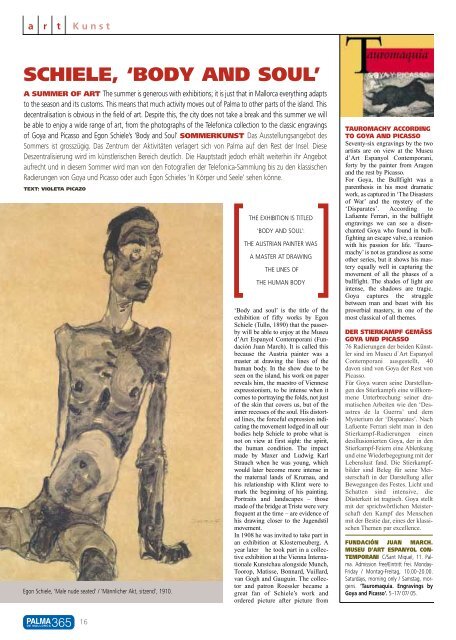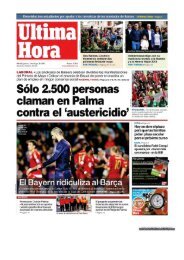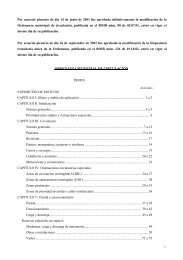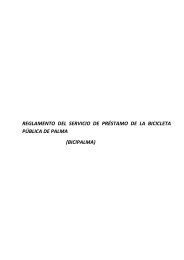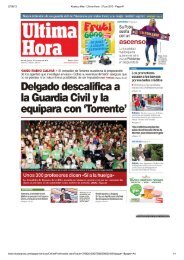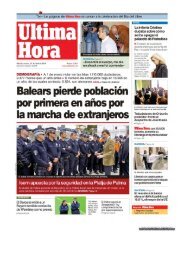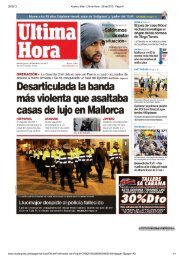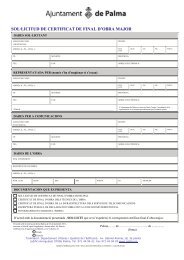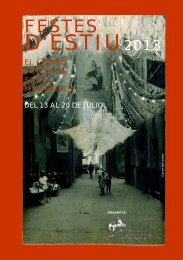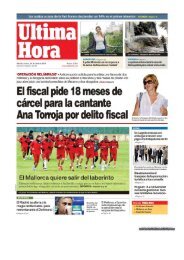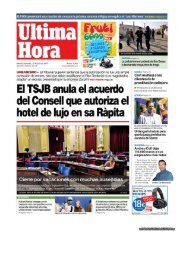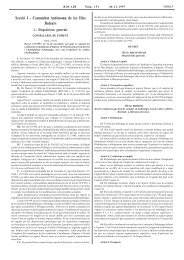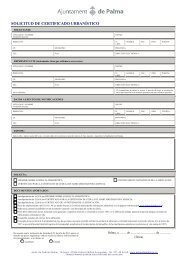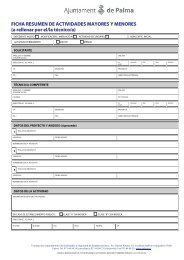e - Ajuntament de Palma
e - Ajuntament de Palma
e - Ajuntament de Palma
Sie wollen auch ein ePaper? Erhöhen Sie die Reichweite Ihrer Titel.
YUMPU macht aus Druck-PDFs automatisch weboptimierte ePaper, die Google liebt.
| a | r | t | Kunst<br />
SCHIELE, ‘BODY AND SOUL’<br />
A SUMMER OF ART The summer is generous with exhibitions; it is just that in Mallorca everything adapts<br />
to the season and its customs. This means that much activity moves out of <strong>Palma</strong> to other parts of the island. This<br />
<strong>de</strong>centralisation is obvious in the field of art. Despite this, the city does not take a break and this summer we will<br />
be able to enjoy a wi<strong>de</strong> range of art, from the photographs of the Telefonica collection to the classic engravings<br />
of Goya and Picasso and Egon Schiele’s ‘Body and Soul’ SOMMERKUNST Das Ausstellungsangebot <strong>de</strong>s<br />
Sommers ist grosszügig. Das Zentrum <strong>de</strong>r Aktivitäten verlagert sich von <strong>Palma</strong> auf <strong>de</strong>n Rest <strong>de</strong>r Insel. Diese<br />
Deszentralisierung wird im künstlerischen Bereich <strong>de</strong>utlich. Die Hauptstadt jedoch erhält weiterhin ihr Angebot<br />
aufrecht und in diesem Sommer wird man von <strong>de</strong>n Fotografien <strong>de</strong>r Telefonica-Sammlung bis zu <strong>de</strong>n klassischen<br />
Radierungen von Goya und Picasso o<strong>de</strong>r auch Egon Schieles ‘In Körper und Seele’ sehen könne.<br />
TEXT: VIOLETA PICAZO<br />
Egon Schiele, ‘Male nu<strong>de</strong> seated’ / ‘Männlicher Akt, sitzend’, 1910.<br />
16<br />
THE EXHIBITION IS TITLED<br />
‘BODY AND SOUL’:<br />
THE AUSTRIAN PAINTER WAS<br />
A MASTER AT DRAWING<br />
THE LINES OF<br />
THE HUMAN BODY<br />
‘Body and soul’ is the title of the<br />
exhibition of fifty works by Egon<br />
Schiele (Tulln, 1890) that the passerby<br />
will be able to enjoy at the Museu<br />
d’Art Espanyol Contemporani (Fundación<br />
Juan March). It is called this<br />
because the Austria painter was a<br />
master at drawing the lines of the<br />
human body. In the show due to be<br />
seen on the island, his work on paper<br />
reveals him, the maestro of Viennese<br />
expressionism, to be intense when it<br />
comes to portraying the folds, not just<br />
of the skin that covers us, but of the<br />
inner recesses of the soul. His distorted<br />
lines, the forceful expression indicating<br />
the movement lodged in all our<br />
bodies help Schiele to probe what is<br />
not on view at first sight: the spirit,<br />
the human condition. The impact<br />
ma<strong>de</strong> by Maxer and Ludwig Karl<br />
Strauch when he was young, which<br />
would later become more intense in<br />
the maternal lands of Krumau, and<br />
his relationship with Klimt were to<br />
mark the beginning of his painting.<br />
Portraits and landscapes – those<br />
ma<strong>de</strong> of the bridge at Triste were very<br />
frequent at the time – are evi<strong>de</strong>nce of<br />
his drawing closer to the Jugendstil<br />
movement.<br />
In 1908 he was invited to take part in<br />
an exhibition at Klosterneuberg. A<br />
year later he took part in a collective<br />
exhibition at the Vienna Internationale<br />
Kunstchau alongsi<strong>de</strong> Munch,<br />
Toorop, Matisse, Bonnard, Vuillard,<br />
van Gogh and Gauguin. The collector<br />
and patron Roessler became a<br />
great fan of Schiele’s work and<br />
or<strong>de</strong>red picture after picture from<br />
TAUROMACHY ACCORDING<br />
TO GOYA AND PICASSO<br />
Seventy-six engravings by the two<br />
artists are on view at the Museu<br />
d’Art Espanyol Contemporani,<br />
forty by the painter from Aragon<br />
and the rest by Picasso.<br />
For Goya, the Bullfight was a<br />
parenthesis in his most dramatic<br />
work, as captured in ‘The Disasters<br />
of War’ and the mystery of the<br />
‘Disparates’. According to<br />
Lafuente Ferrari, in the bullfight<br />
engravings we can see a disenchanted<br />
Goya who found in bullfighting<br />
an escape valve, a reunion<br />
with his passion for life. ‘Tauromachy’<br />
is not as grandiose as some<br />
other series, but it shows his mastery<br />
equally well in capturing the<br />
movement of all the phases of a<br />
bullfight. The sha<strong>de</strong>s of light are<br />
intense, the shadows are tragic.<br />
Goya captures the struggle<br />
between man and beast with his<br />
proverbial mastery, in one of the<br />
most classical of all themes.<br />
DER STIERKAMPF GEMÄSS<br />
GOYA UND PICASSO<br />
76 Radierungen <strong>de</strong>r bei<strong>de</strong>n Künstler<br />
sind im Museu d`Art Espanyol<br />
Contemporani ausgestellt, 40<br />
davon sind von Goya <strong>de</strong>r Rest von<br />
Picasso.<br />
Für Goya waren seine Darstellungen<br />
<strong>de</strong>s Stierkampfs eine willkommene<br />
Unterbrechung seiner dramatischen<br />
Arbeiten wie <strong>de</strong>n ‘Desastres<br />
<strong>de</strong> la Guerra’ und <strong>de</strong>m<br />
Mysterium <strong>de</strong>r ‘Disparates’. Nach<br />
Lafuente Ferrari sieht man in <strong>de</strong>n<br />
Stierkampf-Radierungen einen<br />
<strong>de</strong>sillusionierten Goya, <strong>de</strong>r in <strong>de</strong>n<br />
Stierkampf-Feiern eine Ablenkung<br />
und eine Wie<strong>de</strong>rbegegnung mit <strong>de</strong>r<br />
Lebenslust fand. Die Stierkampfbil<strong>de</strong>r<br />
sind Beleg für seine Meisterschaft<br />
in <strong>de</strong>r Darstellung aller<br />
Bewegungen <strong>de</strong>s Festes. Licht und<br />
Schatten sind intensive, die<br />
Düsterkeit ist tragisch. Goya stellt<br />
mit <strong>de</strong>r sprichwörtlichen Meisterschaft<br />
<strong>de</strong>n Kampf <strong>de</strong>s Menschen<br />
mit <strong>de</strong>r Bestie dar, eines <strong>de</strong>r klassischen<br />
Themen par excellence.<br />
FUNDACIÓN JUAN MARCH.<br />
MUSEU D’ART ESPANYOL CON-<br />
TEMPORANI C/Sant Miquel, 11. <strong>Palma</strong>.<br />
Admission free/Eintritt frei. Monday-<br />
Friday / Montag-Freitag, 10.00-20.00.<br />
Saturdays, morning only / Samstag, morgens.<br />
‘Tauromaquia. Engravings by<br />
Goya and Picasso’. 5 -17/ 07/ 05.


